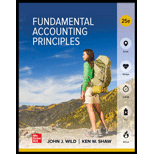
Fundamental Accounting Principles
25th Edition
ISBN: 9781260780222
Author: Wild, John
Publisher: MCGRAW-HILL HIGHER EDUCATION
expand_more
expand_more
format_list_bulleted
Question
Chapter 9, Problem 15E
To determine
Concept Introduction:
Notes receivable or payable:
Notes receivable or payable are issued for credit sales or purchases. Notes are issued for a specific amount and period. The maturity date of the note is the date at which the note becomes due for payment. Notes also have interest which is paid for the period of the note.The interest is calculated for the term of note.
To Prepare:
The
Expert Solution & Answer
Want to see the full answer?
Check out a sample textbook solution
Students have asked these similar questions
Can you solve this general accounting question with accurate accounting calculations?
Please provide the accurate answer to this general accounting problem using appropriate methods.
Could you help me solve this financial accounting question using appropriate calculation techniques?
Chapter 9 Solutions
Fundamental Accounting Principles
Ch. 9 - Credit card sales Prepare journal entries for the...Ch. 9 - Direct write-off method P1 Solstice Company...Ch. 9 - Recovering a bad debt P1 Solstice Company...Ch. 9 - Distinguishing between allowance method and direct...Ch. 9 - Prob. 5QSCh. 9 - Allowance method for bad debts P2 Gomez Corp. uses...Ch. 9 - Reporting allowance for doubtful accounts P2 On...Ch. 9 - Prob. 8QSCh. 9 - Prob. 9QSCh. 9 - Aging of receivables method P3 ^ Net Zero...
Ch. 9 - Prob. 11QSCh. 9 - Prob. 12QSCh. 9 - Prob. 13QSCh. 9 - Prob. 14QSCh. 9 - Prob. 15QSCh. 9 - Prob. 16QSCh. 9 - Prob. 17QSCh. 9 - Prob. 18QSCh. 9 - Prob. 19QSCh. 9 - Prob. 20QSCh. 9 - Prob. 21QSCh. 9 - Exercise 9-1
Accounts receivable subsidiary...Ch. 9 - Prob. 2ECh. 9 - Exercise 9-3
Sales on store credit card
C1
Z-Mart...Ch. 9 - Exercise 9-4
Direct write-off method
Dexter...Ch. 9 - Exercise 9-5 Writing off receivables P2
On January...Ch. 9 - Exercise 9-6 Percent of sales method; write-off...Ch. 9 - Exercise 9-7 Percent of accounts receivable...Ch. 9 - Exercise 9-8 Aging of receivables method P3
Daley...Ch. 9 - Exercise 9-9 Percent of receivables method...Ch. 9 - Exercise 9-10 Aging of receivables schedule...Ch. 9 - Exercise 9-10
Estimating bad debts
P3
At December...Ch. 9 - Exercise 9-11
Notes receivable...Ch. 9 - Exercise 9-12
Notes receivable transactions...Ch. 9 - Exercise 9-14 Honoring a note P4
Prepare journal...Ch. 9 - Exercise 9-15 Dishonoring a note P4
Prepare...Ch. 9 - Exercise 9-16 Selling and pledging accounts...Ch. 9 - Exercise 9-17 Accounts receivable turnover A1 Q...Ch. 9 - Prob. 18ECh. 9 - Prob. 19ECh. 9 - Prob. 20ECh. 9 - Prob. 21ECh. 9 - Prob. 22ECh. 9 - Prob. 23ECh. 9 - Problem 9-1A Sales on account and credit card...Ch. 9 - Problem 9-2A Estimating and reporting bad debts P2...Ch. 9 - Problem 9-3A Aging accounts receivable and...Ch. 9 - Problem 9-4A Accounts receivable transactions and...Ch. 9 - Problem 9-5A Analyzing and journalizing notes...Ch. 9 - Problem 9-1B Sales on account and credit card...Ch. 9 - Problem 9-2B Estimating and reporting bad debts P2...Ch. 9 - Problem 9-3B Aging accounts receivable and...Ch. 9 - Problem 9-4B Accounts receivable transactions and...Ch. 9 - Prob. 5PSBCh. 9 - SP 9 Santana Rey: owner of Business Solutions,...Ch. 9 - Prob. 1GLPCh. 9 - Prob. 1AACh. 9 - Prob. 2AACh. 9 - Prob. 3AACh. 9 - Prob. 1DQCh. 9 - Why does the direct write-off method of accounting...Ch. 9 - Prob. 3DQCh. 9 - Why might a business prefer a note receivable to...Ch. 9 - Prob. 5DQCh. 9 - Prob. 6DQCh. 9 - Anton Blair is the manager of a medium-size...Ch. 9 - Prob. 2BTNCh. 9 - Prob. 3BTNCh. 9 - Prob. 4BTNCh. 9 - Prob. 5BTN
Knowledge Booster
Learn more about
Need a deep-dive on the concept behind this application? Look no further. Learn more about this topic, accounting and related others by exploring similar questions and additional content below.Similar questions
- Can you solve this general accounting question with accurate accounting calculations?arrow_forwardTaron Productions has the following information from its process costing system: beginning work-in-process of 4,800 units (60% complete for conversion costs), 22,500 units started during the period, and ending work-in-process of 3,900 units (40% complete for conversion costs). Using the weighted average method, what are the equivalent units for conversion costs for the period?arrow_forwardCompute the equivalent units of productionarrow_forward
arrow_back_ios
SEE MORE QUESTIONS
arrow_forward_ios
Recommended textbooks for you

 AccountingAccountingISBN:9781337272094Author:WARREN, Carl S., Reeve, James M., Duchac, Jonathan E.Publisher:Cengage Learning,
AccountingAccountingISBN:9781337272094Author:WARREN, Carl S., Reeve, James M., Duchac, Jonathan E.Publisher:Cengage Learning, Accounting Information SystemsAccountingISBN:9781337619202Author:Hall, James A.Publisher:Cengage Learning,
Accounting Information SystemsAccountingISBN:9781337619202Author:Hall, James A.Publisher:Cengage Learning, Horngren's Cost Accounting: A Managerial Emphasis...AccountingISBN:9780134475585Author:Srikant M. Datar, Madhav V. RajanPublisher:PEARSON
Horngren's Cost Accounting: A Managerial Emphasis...AccountingISBN:9780134475585Author:Srikant M. Datar, Madhav V. RajanPublisher:PEARSON Intermediate AccountingAccountingISBN:9781259722660Author:J. David Spiceland, Mark W. Nelson, Wayne M ThomasPublisher:McGraw-Hill Education
Intermediate AccountingAccountingISBN:9781259722660Author:J. David Spiceland, Mark W. Nelson, Wayne M ThomasPublisher:McGraw-Hill Education Financial and Managerial AccountingAccountingISBN:9781259726705Author:John J Wild, Ken W. Shaw, Barbara Chiappetta Fundamental Accounting PrinciplesPublisher:McGraw-Hill Education
Financial and Managerial AccountingAccountingISBN:9781259726705Author:John J Wild, Ken W. Shaw, Barbara Chiappetta Fundamental Accounting PrinciplesPublisher:McGraw-Hill Education


Accounting
Accounting
ISBN:9781337272094
Author:WARREN, Carl S., Reeve, James M., Duchac, Jonathan E.
Publisher:Cengage Learning,

Accounting Information Systems
Accounting
ISBN:9781337619202
Author:Hall, James A.
Publisher:Cengage Learning,

Horngren's Cost Accounting: A Managerial Emphasis...
Accounting
ISBN:9780134475585
Author:Srikant M. Datar, Madhav V. Rajan
Publisher:PEARSON

Intermediate Accounting
Accounting
ISBN:9781259722660
Author:J. David Spiceland, Mark W. Nelson, Wayne M Thomas
Publisher:McGraw-Hill Education

Financial and Managerial Accounting
Accounting
ISBN:9781259726705
Author:John J Wild, Ken W. Shaw, Barbara Chiappetta Fundamental Accounting Principles
Publisher:McGraw-Hill Education
7.2 Ch 7: Notes Payable and Interest, Revenue recognition explained; Author: Accounting Prof - making it easy, The finance storyteller;https://www.youtube.com/watch?v=wMC3wCdPnRg;License: Standard YouTube License, CC-BY